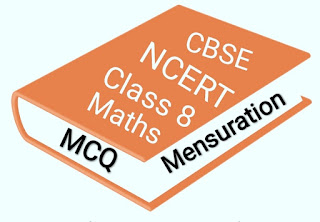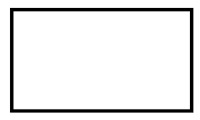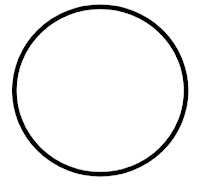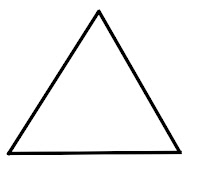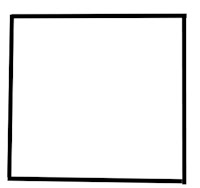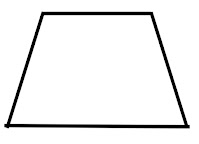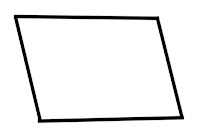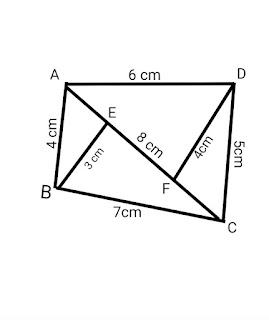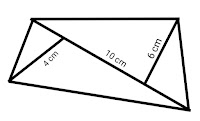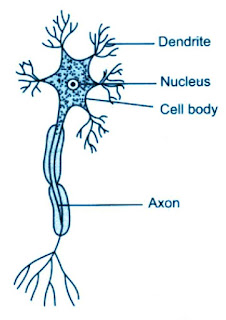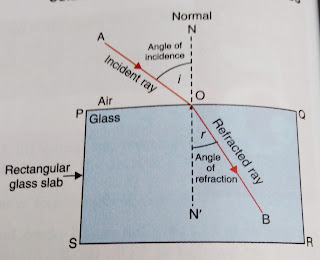MCQ Questions for Class 8 Maths Chapter 11 Mensuration with Answers
MCQ Questions for Class 8 Maths Chapter 11 Mensuration with Answers
-------------------------------------------------------------
Board CBSE
-------------------------------------------------------------
TextBook NCERT
-------------------------------------------------------
CLASS Class 8
--------------------------------------------------------
SUBJECT Maths
----------------------------------------------------------
CHAPTER Chapter 11
-------------------------------------------------------------
SUBJECT Mensuration
--------------------------------------------------------------
Topic Multiple Choice Questions
---------------------------------------------------------
You May Also Like Multiple Choice Questions on -
Also Visit: 1.MCQ Class 8 Science
Question 1.
The given figure is the example of
(a) rectangle
(b) square
(c) circle
(d) Triangle
Answer
Answer 1:
(a) rectangle
Question 2.
The given figure represent
(a) rectangle
(b) Triangle
(c) square
(d) circle
Answer
Answer 2:
(d) circle
Question 3.
The given figure represent
(a) rectangle
(b) circle
(c) Triangle
(d) square
Answer
Answer 3:
(c) Triangle
Question 4.
The given figure represent
(a) rectangle
(b) software
(c) square
(d) Triangle
Answer
Answer 4:
(c) square
Question 5.
The given figure represent
(a) circle
(b) Triangle
(c) trapezium
(d) parallelogram
Answer
Answer 5:
(c) trapezium
Question 6.
The given figure represent
(a) circle
(b) Triangle
(c) trapezium
(d) parallelogram
Answer
Answer 6:
(d) parallelogram
Question 7.
The length of a rectangle is X and breadth is Y. The the area of the rectangle is
(a) X+Y
(b) X-Y
(c) XY
(d) X÷Y
Answer
Answer 7:
(c) XY
Question 8.
The side of a square is A cm. The area of the square is
(a) 4A cm²
(b) A² cm²
(c) 3A cm²
(d) none of the above
Answer
Answer 8:
(b) A² cm²
Question 9.
Base and height of a right angled triangle are x cm and y cm. The area of the triangle is
(a) ½ × xy
(b) ⅓ × xy
(c) ¼ × xy
(d) none of the above
Answer
Answer 9:
(a) ½ × xy
Question 10.
Area of the parallelogram
(a) base × height
(b) base + height
(c) base - height
(d) none of the above
Answer
Answer 10:
(a) base × height
Question 11.
The radius of a circle is R cm. The area of the circle is
(a) 2πr
(b) 2πr²
(c) πr²
(d) none of the above
Answer
Answer 11:
(c) πr²
Question 12.
If the length and breadth of a rectangle are 25cm and 20cm, respectively, then its area is
(a) 90 cm²
(b) 45 cm²
(c) 500 cm²
(d) none of the above
Answer
Answer 12:
(c) 500 cm²
Because: Length = 25 cm
And breadth = 20 cm
Area of rectangle = Length x breadth
= 25 × 20
= 500 cm²
Question 13.
Area of Rhombus
(a) sum of two diagonal
(b) product of two diagonal
(c) ½ × ( product of two diagonals)
(d) none of above
Answer
Answer 13:
(c) ½ × ( product of two diagonals)
Question 14.
The area of a rhombus whose diagonals are of lengths 20 cm and 10 cm is
(a) 200 cm²
(b) 100 cm²
(c) 30 cm²
(d) none of the above
Answer
Answer 14:
(b) 100 cm²
Because:
Area of rhombus = ½ × d1 × d2
A = ½ x 10 x 20
A = 100 cm²
Question 15.
The area of a trapezium is 200 cm², the distance between two parallel sides is 20 cm and one of the parallel side is 5 cm. The other parallel side is:
(a) 15 cm
(b) 10 cm
(c) 5 cm
(d) none of the above
Answer
Answer 15:
(a) 15 cm
Because,
Area of trapezium = ½ × Height × (sum of two sides)
200 = ½ (20) (5 + other side)
5 + other side = (200 x 2)/20
5 + other side =20
other side = (20 - 5) cm = 15 cm
Question 16.
Which of the following is equal to 1 kilolitre?
(a) 1000 millilitres
(b) 100 dm3
(c) 1 dm3
(d) 1000 dm3
Answer
Answer 16:
(d) 1000 dm3
Question 17.
The area of the floor of a room is 50 m². Height of the room is 20 m. Volume of the room is
(a) 140 m³
(b) 120 m³
(c) 100 m³
(d) none of the above
Answer
Answer 17:
(c) 100 m³
Because,
Area of the room= (Area of floor × height)
= (50 × 20)
=100 m³
Question 18.
If the sides of a equilateral triangle be doubled then its area become
(a) 2 times
(b) 3 times
(c) 4 times
(d) none of the above
Answer
Answer 18:
(c) 4 times
Question 19.
What is the total volume of cuboid with dimension (12 cm × 10 cm × 8cm)
(a) 800 cm³
(b) 960 cm³
(c) 1000 cm³
(d) none of the above
Answer
Answer 19:
(b) 960 cm³
Because,
Volume of cuboid = (length × breadth × height)
= (12 cm × 10 cm × 8cm)
= 960 cm³
Question 20.
Find the volume of the cuboid whose length is 20 m, breadth is 10 m and height is 5 m.
(a) 500 m³
(b) 1000 m³
(c) 1500 m³
(d) none of the above
Answer
Answer 20:
(b) 1000 m³
Because,
Volume of cuboid = (length × breadth × height)
= (20 m × 10 m × 5 m)
= 1000 m³
Question 21.
Total surface area of a cuboid is
(a) 2(lb × bh × hl)
(b) 2(lb + bh + hl)
(c) 2h(l + b)
(d) none of the above
Answer
Answer 21:
(a) 2(lb × bh × hl)
Question 22.
Solid figures are
(a) two dimensional figure
(b) three dimensional figure
(c) four dimensional figure
(d) one dimensional figure
Answer
Answer 22:
(b) three dimensional figure
Question 23.
Length and breadth of a rectangle are 15 cm and 10 cm. The perimeter of the rectangle is
(a) 25 cm
(b) 150 cm
(c) 100 cm
(d) 50 cm
Answer
Answer 23:
(d) 50 cm
Because,
Perimeter of the rectangle = 2 (length + Breadth)
=2(15+10)
=50 cm
Question 24.
The height and corresponding base of a parallelogram 45 cm and 30 cm. The area of the parallelogram is
(a) 75 square centimetre
(b) 1350 square centimetre
(c) 1500 square centimetre
(d) 2000 square centimetre
Answer
Answer 24:
(b) 1350 square centimetre
Because,
Area of the parallelogram = (base × Height)
=(45 × 30)
= 1350 square centimetre
Question 25.
The length of three sides of a triangle are 5 cm, 6 cm and 7 cm. Perimeter of the triangle is
(a) 15 cm
(b) 17 cm
(c) 20 cm
(d) 18 cm
Answer
Answer 25:
(d) 18 cm
Because,
Perimeter of a triangle = sum of all three sides
= (5+6+7)
=18 cm
Question 26.
The base of a triangle is 10 cm and its corresponding altitude is 5 cm. The area of the triangle is
(a) 25 square centimetre
(b) 30 square centimetre
(c) 35 square centimetre
(d) 40 square centimetre
Answer
Answer 26:
(a) 25 square centimetre
Because,
Area of a triangle = ½ × base × height
= ½ × 10 × 5
= 25 square centimetre
Question 27.
Side of a square is 4 cm. Its perimeter is
(a) 16 cm
(b) 8 cm
(c) 4 cm
(d) 20 cm
Answer
Answer 27:
(a) 16 cm
Because,
Perimeter of the square = 4 × side
= 4 × 4
16 cm
Question 28.
Side of a square is 8 m. Area of the square is
(a) 32 square metre
(b) 64 square metre
(c) 80 square metre
(d) 50 square metre
Answer
Answer 28:
(b) 64 square metre
Because,
Area of the square = Side × Side
=8 × 8
= 64 square metre
Question 29.
Radius of a semicircle is 7 m. The area of the semicircle
(a) 66 square metre
(b) 88 square metre
(c) 55 square metre
(d) 77 square metre
Answer
Answer 29:
(d) 77 square metre
Because,
Area of the semicircle = ½ × π r²
= ½ × (22/7) × 7×7
= 77 m²
Question 30.
The length of two parallel sides of a trapezium are 10 cm and 15 cm. Distance between the two parallel sides is 20 cm. Find the area of trapezium.
(a) 200 cm²
(b) 210 cm²
(c) 250 cm²
(d) none of the above
Answer
Answer 30:
(c) 250 cm²
Because
Area of trapezium = ½ × (sum of parallel sides) × height
= ½ × (10 + 15) × 20
= 250 cm²
Question 31.
The length of two parallel sides of a trapezium are 3 cm and 1 cm. Distance between the two parallel sides is 3 cm. Find the area of trapezium.
(a) 2 cm²
(b) 4 cm²
(c) 6 cm²
(d) 8 cm²
Answer
Answer 31:
(c) 6 cm²
Because
Area of trapezium = ½ × (sum of parallel sides) × height
= ½ × (3 + 1) × 3
= 6 cm²
Question 32.
The length of two parallel sides of a trapezium are 3 cm and 4 cm. Distance between the two parallel sides is 2 cm. Find the area of trapezium.
(a) 4 cm²
(b) 5 cm²
(c) 6 cm²
(d) 7 cm²
Answer
Answer 32:
(d) 7 cm²
Because
Area of trapezium = ½ × (sum of parallel sides) × height
= ½ × (3 + 4) × 2
= 7 cm²
Question 33.
Length of two diagonals of a rhombus are 16 cm and 18 cm. The area of the rhombus is
(a) 134 cm²
(b) 144 cm²
(c) 150 cm²
(d) 288 cm²
Answer
Answer 33:
(b) 144 cm²
Because,
The area of the rhombus = ½ × (product of diagonals)
= ½ × (16 × 18)
= 144 cm²
Question 34.
Find the area of the given quadrilateral
(a) 21 cm²
(b) 42 cm²
(c) 20 cm²
(d) 28 cm²
Answer
Answer 34:
(d) 28 cm²
Because,
Area of ABCD = (area of triangle ABC + area of triangle ADC)
= (½ × AC × BE) + (½ × AC × DF)
= (½ × 8 × 3) + (½ × 8 × 4)
= 12 + 16
= 28 cm²
Question 35.
Find the area of the given figure
(a) 50 cm²
(b) 60 cm²
(c) 70 cm²
(d) 80 cm²
Answer
Answer 35:
(a) 50 cm²
Because,
= (½ × 10 × 4) + (½ × 10 × 6)
= 20 + 30
= 50 cm²
Question 36.
The area of a rhombus is 40 cm². One diagonal is 8 cm. The other diagonal is
(a) 9 cm
(b) 10 cm
(c) 11 cm
(d) 12 cm
Answer
Answer 36:
(b) 10 cm
Because,
Area of rhombus = ½ × (products of diagonals)
½ × 8 × other diagonal = 40
Other diagonal = 10 cm
Question 37.
The area of a trapezium is 60 cm². Its parallel sides are 12 cm and 18 cm. The distance between the parallel sides is
(a) 5 cm
(b) 4 cm
(c) 6 cm
(d) 8 cm
Answer
Answer 37:
(b) 4 cm
Because,
½ × (sum of two parallel sides) × distance between the parallel sides = area of the trapezium
½ × (12+18) × d = 60
→ d = 4 cm
Question 38.
The shape of a class room is cubical and there are 30 students. Each student occupied 20 cm³ space. The volume of the classroom is
(a) 600 cm³
(b) 900 cm³
(c) 400 cm³
(d) 500 vm³
Answer
Answer 38:
(a) 600 cm³
Because,
The volume of the classroom =( space occupied by one student × no of students)
= 20 × 60
= 600 cm³
Question 39.
The three dimensional shape of a rectangle is
(a) cube
(b) cuboid
(c) cylindrical
(d) cone
Answer
Answer 39:
(b) cuboid
Question 40.
The three dimensional shape of a square is
(a) cube
(b) cuboid
(c) cylindrical
(d) cone
Answer
Answer 40:
(a) cube
Question 41.
The volume of a classroom is 1000 m³. The area of the floor of the room is 250 m². The height of the classroom is
(a) 3 m
(b) 4 m
(c) 5 m
(d) 6 m
Answer
Answer 41:
(b) 4 m
Because,
Height = (volume of the classroom ÷ area of the floor)
=(1000÷250)
= 4 m
Question 42.
The floor of a classroom is a square shaped and length of side 4 m and height of the room is 5 m. The volume of the classroom is
(a) 80 m³
(b) 90 m³
(c) 100 m³
(d) 70 m³
Answer
Answer 42:
(a) 80 m³
Because,
Volume of the room = area of square floor × height
= (4×4) ×5
= 80 m³
Question 43.
Radius of the base of a circular cylinder is 7 m and it's height is 2 m. The volume of the cylinder is
(a) 104 m³
(b) 200 m³
(c) 208 m³
(d) 250 m³
Answer
Answer 43:
(c) 208 m³
Because,
Volume of a cylinder = πr²h
= (22/7) ×(7×7) ×2
=208 m³
Question 44.
Radius of the base of a circular cylinder is 7 m and it's height is 2 m. The curved surface area of the cylinder is
(a) 154 m²
(b) 208 m²
(c) 88 m²
(d) 100 m²
Answer
Answer 44:
(c) 88 m²
Because,
Curved surface area of cylinder = 2πrh
= 2×(22/7) ×7×2
=88 m²
Question 45.
The heights of two right circular cylinders are the same. Their volumes are respectively 25π m³ and 64π m³. The ratio of their base radii is
(a) 5:6
(b) 5:7
(c) 5:4
(d) 5:8
Answer
Answer 45:
(d) 5:8
Because,
(πR²h/πr²h) = (25π/64π)
→(R²/r²) = (25/64)
→(R/r) =( ⅝)
Question 46.
No of rectangular faces of a cuboid are
(a) 6
(b) 4
(c) 2
(d) 8
Answer
Answer 46:
(a) 6
Question 47.
All the 6 faces of a cube are
(a) square
(b) rectangular
(c) circular
(d) different
Answer
Answer 47:
(a) square
Question 48.
A cylindrical box has ____ curved surface and ____ circular faces
(a) one, one
(b) one, two
(c) two, one
(d) two, two
Answer
Answer 48:
(b) one, two
Question 49.
Diagonals of a rhombus are
(a) equal in length
(b) different in length
(c) one is half of the other
(d) none of the above
Answer
Answer 49:
(b) different in length
Question 50.
The amount of space occupied by an object is called its
(a) area
(b) volume
(c) perimeter
(d) none of the above
Answer
Answer 50:
(b) volume
